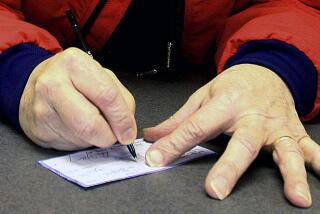Bet the Bottom (Real) Dollar: Service Sniffs Out Bogus Bills
- Share via
Counterfeiting has changed a lot since the days of Emanuel Niger, a German-born sign painter who painstakingly drew and distributed more than $40,000 in $20, $50 and $100 bills in the late 19th Century.
Sophisticated copying machines and offset printing presses have replaced Niger’s pens and brushes as the lure of an endless supply of “free” money continues to tempt both skillful printers and imaginative amateurs.
In fiscal 1986, U.S. Secret Service agents in California seized more than $16 million in bogus bills before they could be passed to the public, according to agency figures.
Nationally, federal agents in fiscal 1986 captured enough fake greenbacks to finance a small fiefdom--$38,848,799, to be exact. The public that year was defrauded of $6.87 million, said Mike Cohen, an agent in the Los Angeles field office.
Holder ‘Is the Loser’
“Whoever is holding the currency is the loser,” he said. Californians who turned in more than $1.65 million in counterfeit bills unwittingly received last year got a polite thank-you from the government but received no reward or compensation for their loss.
“If someone goes in and passes a counterfeit note at the local grocery store, and if the grocer does not catch it and sends it in to the bank, the bank would catch it and debit his account,” Cohen said. “By law, the bank is forced to turn it over to the Secret Service.”
The Secret Service, formed in 1865, when more than one-third of the nation’s currency in circulation was counterfeit, annually seizes close to 90% of counterfeit bills before the funny money hits the streets, Cohen said.
“That is our objective, to get in and seize the plants and the operation. We try to stop it before it hits the streets and before it hits the public.”
Most counterfeiters are printers by trade or have access to printing facilities, said Robert McKnight, an agent in the San Francisco office.
Although counterfeiters’ motivations are varied, most are driven by their egocentric per sonalities, McKnight said, adding that , “They think they can produce something that’s not traceable.”
Three cases in Los Angeles this year illustrate the scope of counterfeit operations.
In one case, a 26-year-old Garden Grove man who worked in a print shop was arrested June 19 on suspicion of printing bogus dollar bills and using them in change machines to get $520 worth of quarters.
In another case last month, a 24-year-old Cypress College print shop employee was arrested and $49,000 in phony $20 bills were confiscated after janitors found some of the currency in trimmed form in the print shop’s trash cans.
Last February, in one of the largest operations in recent history, federal agents seized $17.7 million in high-quality counterfeit $100 bills and arrested two men who the government claims were trying to sell the bills for 30 cents on the dollar, a relatively high price for counterfeit.
‘Not a Crime of Passion’
“You might have an excellent legitimate printer who was approached by someone who made him an offer that he couldn’t refuse,” Cohen said. “Or you might have some young people that got carried away with a print shop in school.”
Whatever the motive, counterfeiting is considered a serious crime against the state. Possession of counterfeit money can get mean a 15-year prison sentence and a $5,000 fine, Cohen said.
“Counterfeiting is definitely . . . not a crime of passion. They have to think about it. It’s a premeditated crime. They have to plan it.”
Some counterfeiters spend years trying to perfect their designs for phony currency, but no bogus bill is completely undetectable, said Richard Adams, a spokesman for the Secret Service in Washington.
The distinctive paper used for genuine Federal Reserve notes is manufactured by Crane & Co., of Dalton, Mass., employing an undisclosed formula and is available only to the government, Adams said.
The Bureau of Engraving and Printing uses meticulously engraved plates and an intaglio printing method that raises the ink off the paper and gives the genuine bill a three-dimensional appearance, Adams said.
Still, Cohen said, the best protection is to keep a eye peeled for suspicious-looking bills.
“Take a genuine note of the same denomination and set them side by side and look at them closely,” he said. “You’ll see little red and blue fibers. Counterfeit money does not have the same quality.
“They don’t have the same high-tech equipment,” he said. “A good note looks good because of its high quality and the craftsmanship at the Bureau of Engraving and Printing.”
More to Read
Sign up for Essential California
The most important California stories and recommendations in your inbox every morning.
You may occasionally receive promotional content from the Los Angeles Times.













